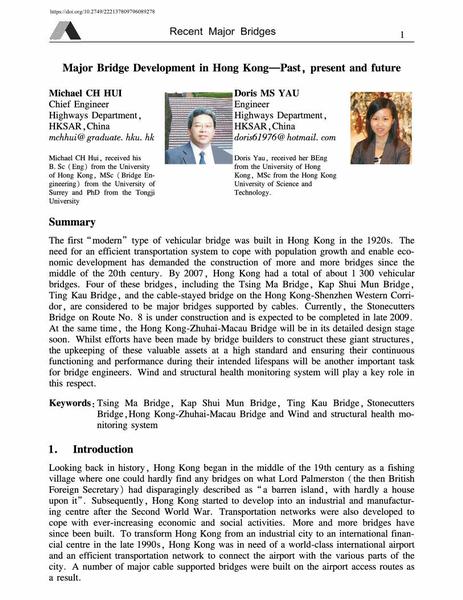Major Bridge Development in Hong Kong – Past, present and future

|
|
|||||||||||
Bibliografische Angaben
| Autor(en): |
Michael Ch. Hui
Doris Ms Yau |
||||
|---|---|---|---|---|---|
| Medium: | Tagungsbeitrag | ||||
| Sprache(n): | Englisch | ||||
| Tagung: | IABSE Workshop: Recent Major Bridges, Shanghai, China, 11-12 May 2009 | ||||
| Veröffentlicht in: | IABSE Workshop Shanghai 2009 | ||||
|
|||||
| Seite(n): | 165-177 | ||||
| Anzahl der Seiten (im PDF): | 13 | ||||
| Jahr: | 2009 | ||||
| DOI: | 10.2749/222137809796089278 | ||||
| Abstrakt: |
The first "modern" type of vehicular bridge was built in Hong Kong in the 1920s. The need for an efficient transportation system to cope with population growth and enable economic development has demanded the construction of more and more bridges since the middle of the 20th century. By 2007, Hong Kong had a total of about 1 300 vehicular bridges. Four of these bridges, including the Tsing Ma Bridge, Kap Shui Mun Bridge, Ting Kau Bridge, and the cable-stayed bridge on the Hong Kong-Shenzhen Western Corridor, are considered to be major bridges supported by cables. Currently, the Stonecutters Bridge on Route No. 8 is under construction and is expected to be completed in late 2009. At the same time, the Hong Kong-Zhuhai-Macau Bridge will be in its detailed design stage soon. Whilst efforts have been made by bridge builders to construct these giant structures, the upkeeping of these valuable assets at a high standard and ensuring their continuous functioning and performance during their intended lifespans will be another important task for bridge engineers. Wind and structural health monitoring system will play a key role in this respect. |
||||
| Stichwörter: |
Wind Stonecutters Bridge
|
||||

